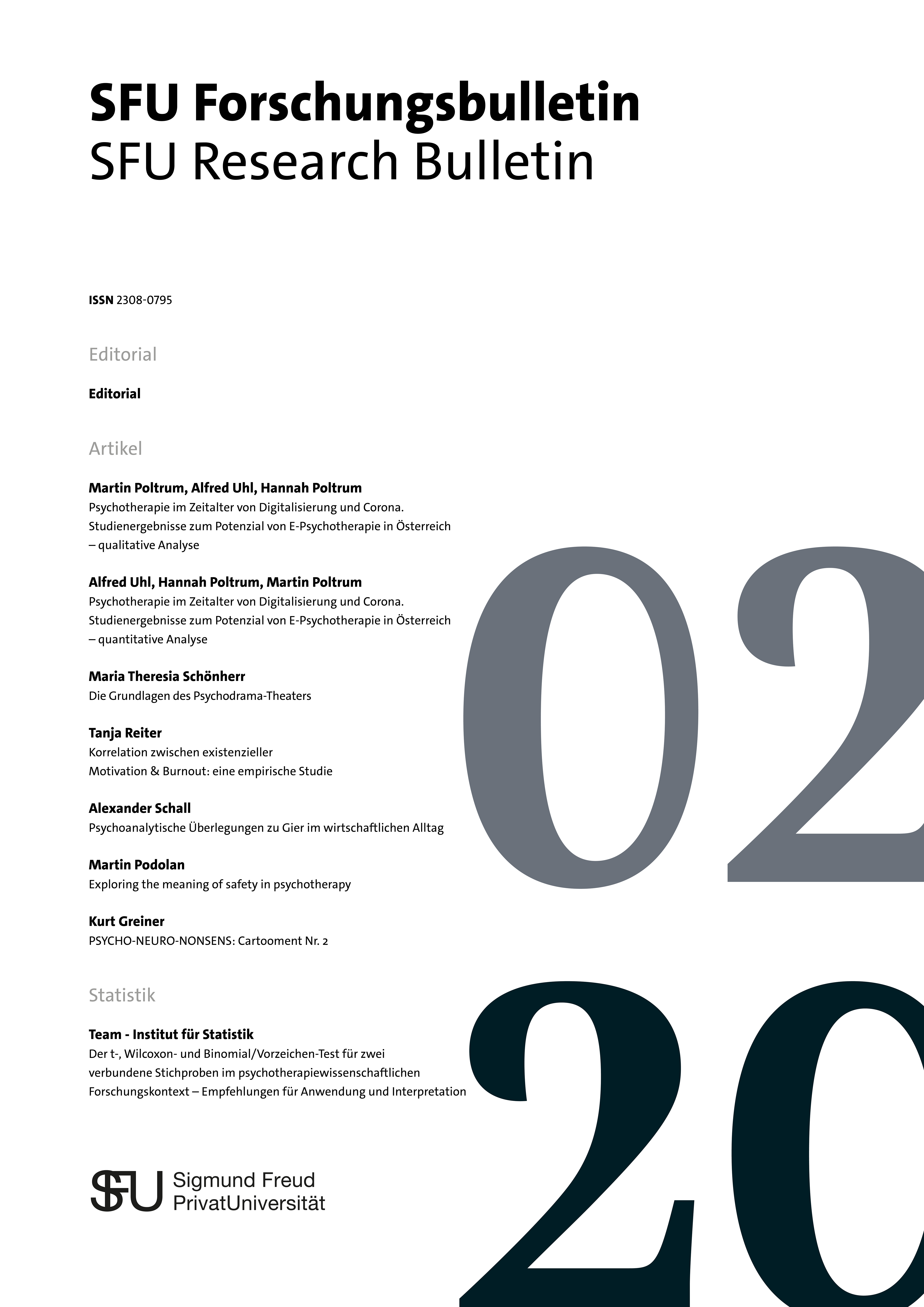Psychotherapy in the Age of Digitalization and Corona
Study results on the potential of E Psychotherapy in Austria – qualitative analysis
DOI:
https://doi.org/10.15135/2020.8.2.1-24Abstract
Due to the CoViD-19 pandemic, Austrian psychotherapists for the first time were entitled to practice psychotherapies via telephone or video telephony (e-psychotherapy) in mid-March 2020. A survey involving 717 Austrian psychotherapists was carried out to determine the experiences they made with these new treatment modalities and their attitude towards e-psychotherapeutic treatments prior and after this change. In the qualitative part of the study presented in this article, the advantages and disadvantages of e psychotherapy are compared to face-to-face treatment based on the surveyed therapists’ perceptions, with particular emphasis on the implications for interventions, methods and patient groups. For the quantitative part of the study consult the second article in this issue of the SFU Research Bulletin (02/2020).
References
Boss, M. (1979). Begegnung in der Psychotherapie. In M. Boss (Hrsg.), Von der Psychoanalyse zur Daseinsanalyse. Vortrag von 1964 (S. 287–294). Wien: Europa Verlag.
Brücher, K. (2015). Psychotherapeuten, Prostituierte und andere. Ein Strukturmodell der therapeutischen Beziehung mit einem Seitenblick auf Jaspers. In J. Zimmermann, W. Gräßler, C. Sülz, M. Heinze (Hrsg.) Psychotherapie, Naturwissenschaft und Religion (S. 131–149). Lengerich: Pabst Science Publishers.
Cook, J. & Doyle, C. (2002). Working Alliance in Online Therapy as Compared to Face-to-Face Therapy: Preliminary Results. Cyber Psychology & Behaviour 5(2), S. 95–105.
Eichenberg, C. (2020). Psychotherapie in der Coronakrise: Trendwende in der Online-Psychotherapie. Deutsches Ärzteblatt, 6, S. 255–256. siehe auch:
https://www.aerzteblatt.de/archiv/214316/Psychotherapie-in-der-Coronakrise-Trendwende-in-der-Online-Psychotherapie#literatur (abgerufen am 25.11.2020)
Grawe, K., Donati, R., & Bernauer, F. (1994). Psychotherapie im Wandel. Von der Konfession zur Profession. Göttingen, Bern, Toronto, Seattle: Hogrefe.
Henry, W.P. & Strupp, H.H. (1994). The therapeutic alliance as interpersonal process, In A.O.
Horvath & L.S. Greenberg (Hrsg.), The working alliance: Theory, research and practice (S. 51–84). New York: Wiley.
Jung, C.G. (1947/1973). Die Psychologie der Übertragung. Erläutert anhand einer alchimistischen Bilderserie. Olten und Freiburg im Breisgau: Walter.
Maio, G. (2017). (Hrsg.). Auf den Menschen hören. Für eine Kultur der Aufmerksamkeit in der Medizin. Freiburg im Breisgau: Herder.
Probst, T., Stippl, P., & Pieh, C. (2020). Changes in Provision of Psychotherapy in the Early Weeks of the COVID-19 Lockdown in Austria. International Journal of Environmental Research and Public Health, 17(11), S. 3815. siehe dazu: https://www.ncbi.nlm.nih.gov/pmc/articles/PMC7312759/ (abgerufen am 25.11.2020)
Simpson, S.G., & Reid, C.C. (2014). Therapeutic alliance in videoconferencing psychotherapy: a review. Australian Journal of Rural Health, 22(6), S. 280–299.
Downloads
Published
Versions
- 2020-12-29 (3)
- 2020-12-28 (2)
- 2020-12-23 (1)
Issue
Section
License
The reproduction of articles published in any form is allowed under the condition that the citation is comprehensive. Prints in other publication media or public media require the written consent of the editor and can be requested under: forschung@sfu.ac.at
